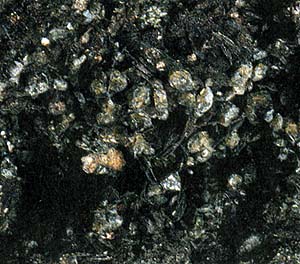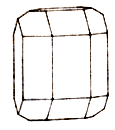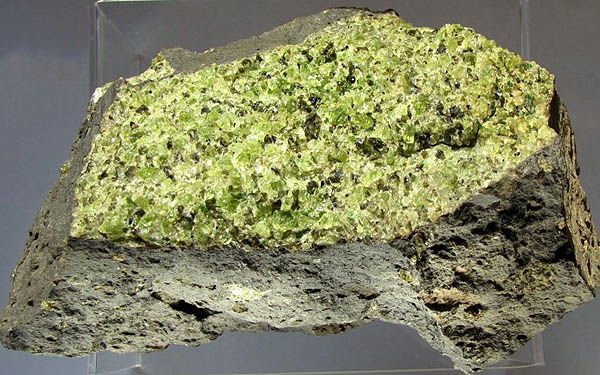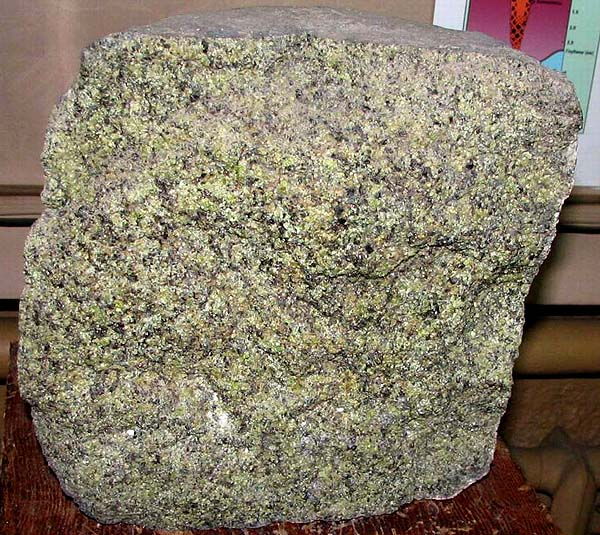Stone, minerals and semiprecious of the world stone
Silicate: Olivine -->rus
 Diagnostic cart.
Diagnostic cart.
On a photo. Aggregate of crystals of olivine and biotite.
(Mg, Fe)2 SiO4
Crystal structure rhombic
Hardness on the Mohs scale 6,5-7
Specific unit weight mass 3,3
Cleavage easy
Fracture, break padman
Colors green
Colors in powder triturate white
Glance (glitter, glare) glassy, fat

Precious transparent varieties name peridotite and chrysolite is a silicate of magnesium and iron. Glance (glitter, glare) glassy. Transparent, rarer transparent. Colors olive-green(from where and the name). A line is white. Fracture, break padman. Cleavage imperfect, fragile. Appears in the magmatic rocks of the first and ultrabasic team. Crystals (rhombic Crystal structure) are rare, more frequent there are grainy aggregates or tumours of the rounded form. Widespread mineral of magmatic rocks of the first or ultrabasic team. Olivine got the name on the color, to similar with the color of garden-stuffs of olive. Olivine is main rockforming minerals of ultrabasic rocks and stone meteorites.
Olivine is olive-green mineral of the olivine group, found in igneous and metamorphic rocks. The clear-green variety (peridot) is used as a gemstone. Composition: magnesium iron silicate. Formula: (MgFe)2SiO4. Crystal structure: orthorhombic. Also called: chrysolite 2) any mineral in the group having the general formula (Mg,Fe,Mn,Ca)2SiO4.
Olivine is a sosoloid of forsterite and fayalite (Fe2Si04). The crystalline type of this mineral is very changeable: grains of wrong outlines are widespread in intrusion, irruption rocks, and the idioblasts of regular shape are ordinary in effusive extrusive, prismatic and plate tablet lamellar type. Colouring changes from green at typical olivine (from here the name: from the color of green olive - olive) to greenish-yellow one, chlorine, brown-yellow, black and due to the second changes of red color. Physical properties, such as specific gravity and fusibility, are changeable in accordance with variations of chemical composition. Olivine is exposed to the changes both under the action of water solutions, circulatory on a depth and under act of carbonic acid on-the-spot. Often substituted for olivine a serpentine which can save the crystallography forms of the first (pseudomorphosis).
Chemical composition (chemistry, compound). Olivine has stand chemical composition: it is mix-crystals of molecules of oxide of magnesium (MGO), protoxides of iron (FeO) and silex (SiO2). Composition of olivine hesitates in the followings limits: MgO 50-45%, FeO 8-12%, SiO2 34-41%; admixtures: oxide of nickel (NiO) 0-0,5%, oxide of cobalt (CoO) 0,01-0,05%.К it is belonged the minerals of group of olivine forsterite (clean magnesia olivine), Mg2SiO4, and fayalite (clean ferrous olivine), Fe2SiO4. Actually olivine, 2(Mg, Fe) O*SiO2, is mix-crystals, consisting of both molecular groups.
Form of crystalline excretions. Usually dense the masses, crystals are rare, as a rule, with well expressed bipyramid (dipyramid). Crystalline structure. Nesosilicate. Class of symmetry of Rhombo-bipyramidal group- mmm. Cleavage good on (010) and (100). Aggregates. Dense, grainy, downlow.
Diagnostic indication.
At influence of muriatic acid forms jelly-like mass. Not melt fuse. In HCl olivine does not almost dissolve even in powder triturate, but there is rapid decomposition in concentrated H2SO4, thus SiO2 falls out in jelly-like tremelloid sediment. Bottle glass-green, yellow, gold, brown, grey color. Entangling transparent olivine is possible with such transparent green stone, as Beryl, Chrysoberyl, Demantoide, Diopside, moldavite, praseolite, Prehnite, Sinhalite, emerald, vesuvianite. The characteristic diagnostic sign of chrysolite is his high birefringence. At the large thickness of the cut stone a double refraction is distinct evidently with a naked eye.
Origin provenance genesis.
This widely known, widespread mineral almost always has magmatic genesis, rarely - contact-metamorphic. Olivine is the substantial and characteristic component of peridotite, ultrabasic orthorocks.
Deposit minefield mine field occurrence subsoil.
Good crystalline formations are found on the Egyptian island of Zeberged in the Red sea, in the state of Minas-zherays (Brazil), in the state Queensland (Australia) on the island of Fer-er (Farerskie о-ва). Other known locations - in the states Arizona and New Mexico and in Norway. With glass brilliance found out transparent crystals in Val'-Malenko (province of Sondrio) and in Monte-padriya (province of Sassa-ri). Olivinovye basalt ragstone is on Etne, and olivine gabbro - near Son-dalo (province of Sondrio).
Use is on jeweller business.
The differences of olivine, applied on jeweller business, have forsterite composition with maintenance of iron 10-15% and magnesium - 85-90%; they are known under the names of peridotite and chrysolite. The different types of cutting are used, as a rule, a preference gives oneself up the rounded form with in a number of fasings. Use cutting as a diamond. This semiprecious stone is rarely applied for the decoration of rings, as it collapses easily.
The value of word of peridotite, having the French origin, is unknown. Possibly, in him there is a hint on plenty of verges at the crystals of peridotite. Chrysolite (from Greek. chrysos - gold and lithos - stone) is a synonym, more accepted in mineralogy, however in antiquity it had more wide value and belonged not only to peridotite but also to to to many to other goldish stone. Glance (glitter, glare) glassy or a bit fatty. Unsteady in relation to sulphuric acid. Taking into account property of chrysolite crack at strong tensions, mounting, it is always placed on metallic bottom layer. Dark stone of lighten by burning. Large rareness is presented by peridotite Cat's Eye and star-shaped, stellar, stellate peridotite. A major deposit on the volcanic island of Zeberget in the Red sea was exploited 3500 years back. Here on the walls of cracks there are magnificent crystals in serpentinous peridotite.
For cutting serpentinite quarries supply with good material also in Overhead Burma (more north-eastern Mogoka). Less considerable deposits are known in Australia (state is Queensland), Brazil (state of Minas-zherays), CIS, Republic (as sputnik satellite of diamonds) of south Africa, USA (state is Arizona, New Mexico, Hawaii), Zaire. In Europe a chrysolite be found in Norway. To Europe this stone left crusaders. In middle ages it was widely used for the decoration of church utensil. Popularity of him was saved and in the epoch of baroque. However now from comparatively low hardness it passed to the second-rate jeweller stone. For a chrysolite plate tablet lamellar or step cutting is usually used, rarer - diamond; to mount him desirably in gold.
The largest cut chrysolite is weighed by 310 carat. It was found on the island of Zeberget and now kept in Smitsonovskom institute in Washington. There are the cut chrysolites of meteoritic origin in the CIS. (They were found in a meteorite, falling down in 1749 in East Siberia.) In the Diamond fund kept also unique in color and to transparency cut oval form chrysolite with Zebergeta by mass 192,6 carat.

"Covering" green Garnet olivine on pricking out of basalt (volcanic igneous rock) - does not meet in a kimberlite

Olivine. Shavaryn-Caram, Khangayskoe upland, Mongolia. A photo: © A.A. Evseev.
